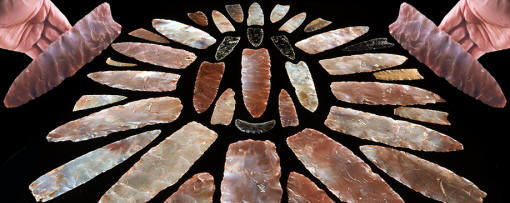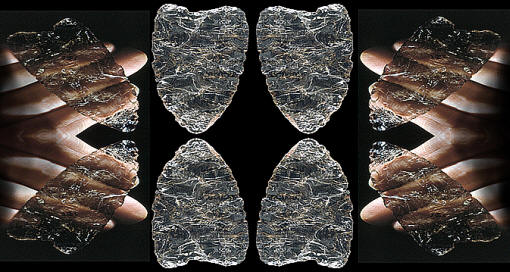|
"In 1988, 56 flaked
stone artifacts attached to a large wood frame with heavy copper wire
were acquired by Forrest Fenn in Santa Fe, New Mexico."--------1999,
George Frison & Bruce Bradley, "The Fenn Cache: Clovis Weapons &
Tools" p. 22.
"The exact
location of its discovery (the Fenn
cache) is not known, but apparently
came from the general area where Wyoming, Idaho, and Utah meet."------1999,
George Frison, "The Late Pleistocene Prehistory of the Northwestern
Plains, the Adjacent mountains, and Intermontane Basins," The
Ice Age Peoples Of North America, Environments, Origins, and Adaptations,
p. 272-273.
"---we
have learned that the discovery (of
the Fenn cache) was made soon after
the turn of the century, possibly in 1902."----1999,
George Frison & Bruce Bradley, "The Fenn Cache: Clovis Weapons &
Tools" p. 22.
"The Fenn cache contained 56 ochre-covered
lithic items, including projectile points, point preforms, large
bifaces, a crescent, and a single blade."---------1999,
George Frison, "The Late Pleistocene Prehistory of the Northwestern
Plains, the Adjacent mountains, and Intermontane Basins," The
Ice Age Peoples Of North America, Environments, Origins, and Adaptations,
p. 272.
"The term cache is
applied to certain forms of storage of property and in archaeology it is
employed to designate more especially certain deposits of implements and
other objects, mainly of stone and metal, the most noteworthy consisting
of flaked flint blades and disks (bifaces)."---------1912,
Frederick Webb Hodge, "Cache Discs (early stage
bifaces) and blades (late/last stage bifaces)," Handbook Of American Indians
North Of Mexico, part 1, p. 178.

THE FENN CACHE
CLOVIS CULTURE
BORDER AREA OF UTAH, IDAHO OR WYOMING
The Fenn Clovis cache is both extraordinary and
mysterious. The cache is extraordinary for its large size, quality of
manufacture, diversity of artifact types, and for the fact that it's the
only cache that has been found to contain a crescent. The cache is mysterious for the fact that
no one knows exactly where or how the cache was discovered. |
|
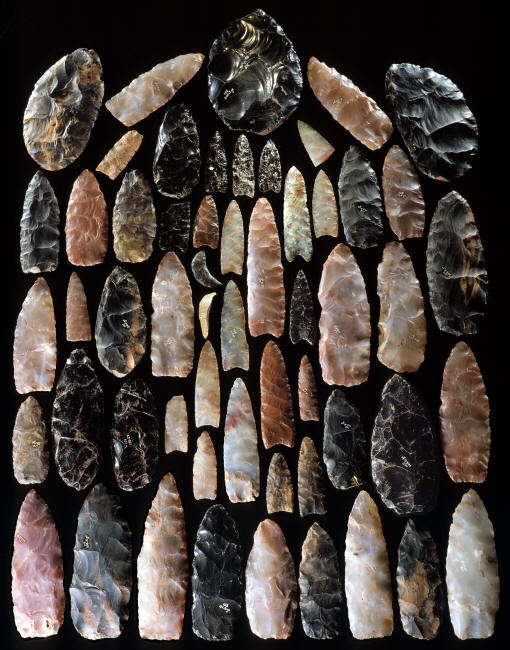
CLICK ON PICTURE FOR LARGER IMAGE
ALL OF THE FENN CACHE
ARTIFACTS
CLOVIS CULTURE
BORDER AREA OF UTAH, IDAHO OR WYOMING
This picture shows all 56 of the Fenn
cache artifacts that were discovered sometime around 1902 somewhere
in the border area of Utah, Wyoming and Idaho. Knowledge of the
initial discovery of the Fenn cache is reported to be "vague
and ambiguous." There is no name given for the finder. One report of
the discovery of the Fenn cache describes it as having been found in
a cultivated field. Another account describes how it was found in a
"skin bag" inside of a dry cave.
Out of the 56 artifacts in the Fenn cache 31 of them are
large percussion flaked bifaces. The largest biface (at top center)
is
sometimes referred to as a "platter biface," because of its large round
shape, and sometimes as a biface core. This example is made of opaque Obsidian and it measures 8 5/16
inches (21.1 cm) long and 5 3/4 inches (14.5 cm) wide. The smallest
biface in the Fenn cache is made of Green River Formation chert and it
measures 5 5/16 inches (13.5 cm) long and 2 3/8 inches (60 cm) wide.
The Fenn cache has more Clovis points than any other cache.
Frison and Bradley identify 23 finished and unfinished Clovis points
in the Fenn cache. The longest Clovis point in the cache is made of
red Utah agate and
measures 8 3/8 inches (21.2 cm) long and 2 1/8 inches (5.3 cm) wide. The
smallest Clovis point is made of Green River Formation chert and has
some impact tip damage. It measures 3 1/8 inches (7.9 cm) long.
The Fenn cache contains one crescent which is important for
the fact that it's the only known example ever found in a Clovis
cache. Only one unifacial tool was found in the Fenn cache which
is a typical Clovis blade that was struck from a prepared core.
The artifacts in the Fenn cache are made of Obsidian, Green River
Formation chert, red jasper, Quartz crystal, and Utah agate. The most
exotic material is the Quartz crystal. Three Clovis points in this
cache are made of Quartz crystal that is slightly smoky. All three
of these points are described as possibly having been resharpened.
A coating of red ochre adheres to the surface of most of the
artifacts in the Fenn cache which suggests a possible ritual
connection. |
|
|
The Fenn cache was named after Forrest Fenn who
purchased the collection in 1988. Archaeologists first become aware of
the Fenn cache later in that same year when the owner contacted George
Frison at the University of Wyoming after reading about the East Wenatchee Clovis
cache in the National Geographic Magazine. |
|

CLICK ON PICTURE FOR LARGER IMAGE
QUARTZ CRYSTAL CLOVIS
POINTS
FENN CACHE
BORDER AREA OF UTAH, IDAHO OR WYOMING
The most exotic material in the Fenn Cache is the Quartz
crystal. This material has turned up in the form of Clovis points from
coast-to-coast in the United States. So for either esthetic (beautiful),
or for some other reason, this glass-like material was popular among
Paleo-Indian tool makers. These three Clovis points were found in
the Fenn cache. They are all made from Quartz crystal that is
slightly smoky. All three points are described as possibly having
been resharpened. The longest point measures 4 inches (10.1 cm)
long. |
|
|
Knowledge of the initial discovery of the Fenn cache is
reported to be "vague and ambiguous." There is no name given for the
finder. But it's thought that the cache was discovered sometime around
the turn of the century in about 1902. |
|
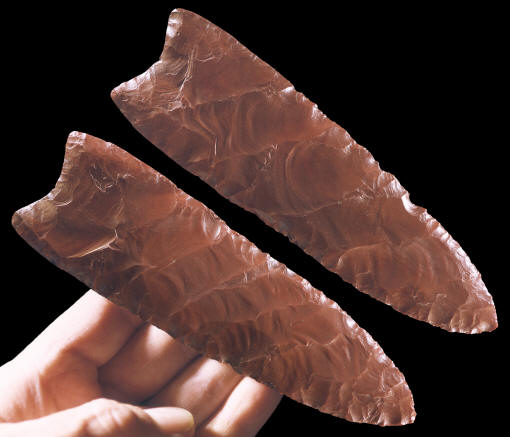
CLICK ON PICTURE FOR LARGER IMAGE
MOST SKILLFULLY CRAFTED
CLOVIS POINT
FENN CACHE
BORDER AREA OF UTAH, IDAHO OR WYOMING
This Clovis point is exceptional for the craftsmanship it displays.
It's most remarkable feature is the very uniform diagonal and
parallel edge-to-edge flaking pattern. These flakes were removed by
percussion. Some flintknappers believe this manufacturing technique
was done by indirect percussion flaking. Today's most expert
flintknappers would find it very difficult to duplicate this point.
This type of flaking is not rare in western Clovis artifacts but
it's rare to see it so uniformly done. The other remarkable feature
about this point is that it's made from a blood red colored stone
that is red jasper from the Bighorn Mountains in northern Wyoming.
The fact that this large Clovis point was so remarkably well crafted
out of red blood colored stone similar to the color of red ochre,
might suggest that its intended purpose was to be used as a "special
ritual item." This Clovis point measures 6 inches (15.2 cm) long and
1 13/16 inches (4.6 cm) wide. |
|
|
One report of the discovery of the Fenn cache
describes it as having been found in a cultivated field. Another account
describes how it was found in a "skin bag" inside of a dry cave.
Although the Fenn cache artifacts don't show any signs of damage that
could be conclusively attributed to
farm equipment, there have been caches found in cultivated fields that
have no damage. But in fact, biface number 122 in the cache is described
as, "One deep, wide flake scar is modern damage on unknown origin." So a
gambler might bet on a cultivated field find. If this Clovis cache was
found in a "skin bag," it would be the only Clovis cache ever found in this way.
Exactly how the Fenn cache was
originally discovered will probably remain a mystery. |
|
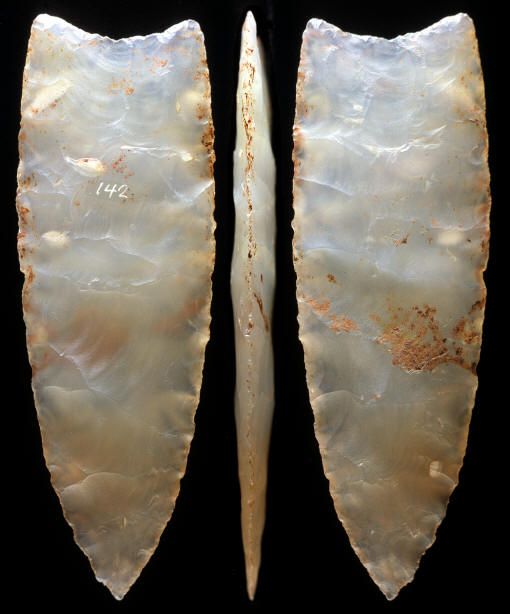
CLICK ON PICTURE FOR LARGER IMAGE
CLOVIS POINT
FENN CACHE
BORDER AREA OF UTAH, IDAHO OR WYOMING
This picture shows a good
example of a complete unbroken "classic" western style Clovis point. It
was shaped with fairly uniform percussion flaking and the edges were
straightened with well done pressure flaking. It has a fairly shallow
basal concavity and it's multiple fluted on both sides. Red ochre has
also coated widely spaced areas on both sides. This point is made of Utah agate and it
measures 4 3/16 inches (10.7 cm) long. |
|
|
Caches, as they relate to archaeology, are represented in
number by two or more artifacts. The majority of these caches have been
found buried in the ground. Originally, they may have been deliberately
buried or they may have become buried in time by natural forces. Caches
of stone artifacts have also been found in caves, rock crevices, tombs and on sacred
sites where artifacts were thrown into bodies of water, such as cenotes,
as offerings to important gods. Most Clovis caches seem to have been
deliberately buried in the ground. |
|
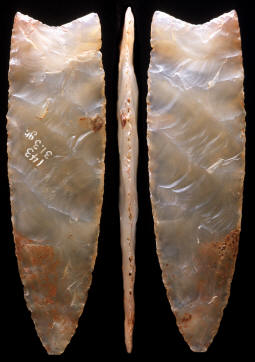 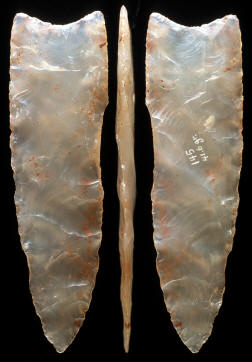
CLICK ON SEPARATE PICTURE FOR LARGER IMAGE
CLOVIS POINTS
FENN CACHE
BORDER AREA OF UTAH, IDAHO OR WYOMING
Both of these Clovis points
are similar in shape and both have obvious encrusted areas of red ochre
on their surfaces. The point on the left has a small portion of the tip
missing that may have happened from use. It also has several large
diagonal flakes removed from both sides that is a typical western Clovis
percussion flaking technique. The point on the right is interesting for
the several over-shot flakes that remain untrimmed along the edges. Both
of these points are made of Utah agate. The point on the left measures 4
1/2 inches (11.4 cm) long and the point on the right measures 5 1/4
inches (13.3 cm) long. |
|
|
Clovis caches are usually discovered by people
who were either surface collecting in cultivated
fields (the Drake cache) or
by people who were working on or observing construction or landscaping sites (McKinnis
cache, Anzick cache, Simons cache) where
large or small amounts of earth was being moved. |
|
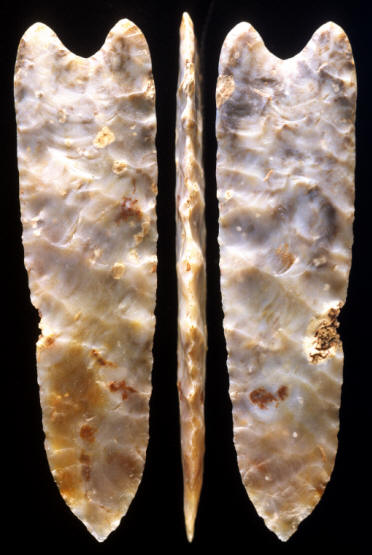
CLICK ON PICTURE FOR LARGER IMAGE
CLOVIS POINT
FENN CACHE
BORDER AREA OF UTAH, IDAHO OR WYOMING
This is the most unusually
shaped Clovis point in the Fenn cache. It has a very deep concave base
and the basal ears are rounded. Both of these traits are similar to the
Colby site Clovis points. This point also has very nicely done diagonal
flaking. There is an inclusion-flaw on one edge that would seem to
weaken the point. The tip of the point has also been resharpened. This
Clovis point was made from a material that came from a source near the
Colby mammoth kill site on the western slope of the Bighorn mountains in
Wyoming. It's believed that this material is from the Amsden Formation
of Pennsylvania age. This point measures 5 15/16 inches (15. cm) long. |
|
|
Approximately two or more
dozens of Clovis caches of various sizes and content have been
discovered to date. They are rare enough to cause a strong general
interest as each new cache is discovered. More and more of
them seem to be reported at an ever increasing rate. One of the most recent being the Mahaffy cache that was
discovered in 2008 in Boulder, Colorado during a landscaping project.
This cache contains 83 bifaces and flakes that were found with a shovel in only 18
inches of earth. |
|
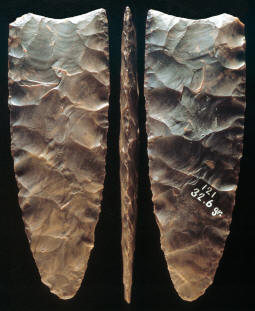 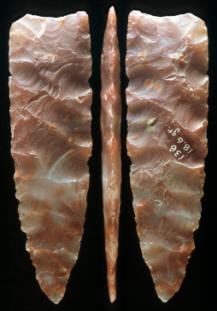
CLICK ON PICTURES FOR LARGER IMAGES
CLOVIS POINTS
FENN CACHE
BORDER AREA OF UTAH, IDAHO OR WYOMING
Both of these Clovis points
have a small portion of one basal ear missing indicating they may have
been damaged from use. The point on the left is made of Green River
Formation chert and it measures 4 1/8 inches (10.5 cm) long. The point
on the right is interesting for the fact that it, along with another
small Clovis point in the cache, are the thinnest and both measure 1/4
inch (6.6 mm) thick. This Clovis point is made of Utah agate and it measures 3 11/16 inches (9.3
cm) long. |
|
|
The Fenn cache is
impressive for its size of 56 artifacts and the fact that many of them
are fairly large percussion flaked bifaces. The largest Clovis cache was
found in Montana and is known as the Anzick cache. The Anzick cache contains slightly over 100 artifacts that are
represented by all stages of bifaces, including finished Clovis points
and bone foreshafts. |
|
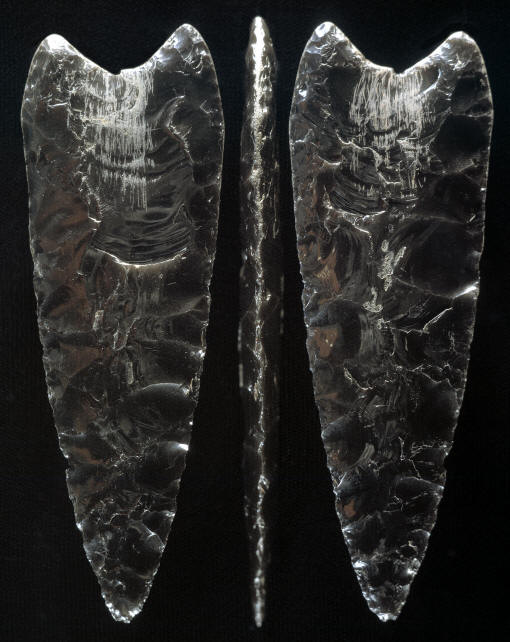
CLICK ON PICTURE FOR LARGER IMAGE
CLOVIS POINT
FENN CACHE
BORDER AREA OF UTAH, IDAHO OR WYOMING
One of the
most interesting feature of this Clovis point are the scratches in the
hafting area. These surface abrasions were apparently used to help
secure the point to the material it was hafted to. It's not uncommon to
see basal scratches on
other Obsidian Clovis points. This point is also reported to have
retained some of the original amber residue in the scratches that would
have acted like glue to hold it securely in place. Another interesting
feature of this point are its rounded basal ears that are similar to the
Colby Clovis points from the Colby mammoth kill site in north central
Wyoming. This Clovis point
is made of black opaque Obsidian and
measures 4 3/8 inches (11 cm) long.
|
|
|
Most of the artifacts that have been found in Clovis caches
are in the form of percussion flaked bifaces and the Fenn cache is no
exception. Out of the 56 artifacts in the cache, 31 of them are large
percussion flaked bifaces. The largest biface in the Fenn cache is a
type that is
sometimes referred to as a "platter biface" because of its large round
shape. This example is made of opaque Obsidian and it measures 8 5/16
inches (21.1 cm) long and 5 3/4 inches (14.5 cm) wide. The smallest
biface in the Fenn cache is made of Green River Formation chert and it
measures 5 5/16 inches (13.5 cm) long and 2 3/8 inches (60 cm) wide. |
|
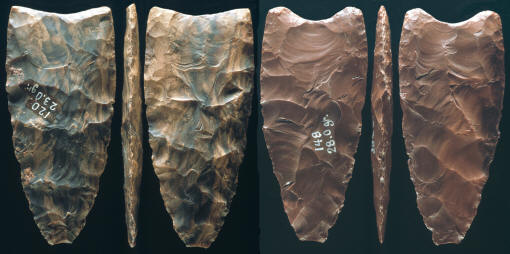
CLICK ON PICTURE FOR LARGER IMAGE
CLOVIS POINTS
FENN CACHE
BORDER AREA OF UTAH, IDAHO OR WYOMING
This picture shows the two
smallest Clovis points in the Fenn cache. Both of them have the tips of
their points missing from impact damage indicating they were probably
being used until they were placed in the cache. They also appear to have
been resharpened one or more times. The point on the left is made of
Green River Formation chert and it measures 3 1/8 inches (7.9 cm) long.
The point on the right is made of red Jasper possibly from northern
Wyoming. It measures 3 1/4 inches (8.3 cm) long. |
|
|
Not all Clovis caches
contain Clovis points. The Fenn cache is unique for having more
Clovis points than any other cache. Frison and Bradley identified 23
finished and unfinished Clovis points in the Fenn cache. The longest
Clovis point in the cache is made of red Utah agate that
measures 8 5/16 inches (21.2 cm) long and 2 1/8 inches (5.3 cm) wide. The
smallest Clovis point is made of Green River Formation chert and has
some impact tip damage. It measures 3 1/8 inches (7.9 cm) long. |
|
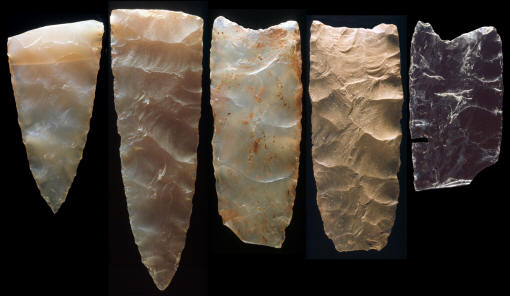
CLICK ON PICTURE FOR LARGER IMAGE
BROKEN CLOVIS POINTS
FENN CACHE
BORDER AREA OF UTAH, IDAHO OR WYOMING
Most of the artifacts in
the Fenn cache were newly made and never used. But as this picture
shows there is damage on several of the
Clovis points that indicate some of them were being used. At least five
or more have broken tips from impact damage, three of them can be seen
in this picture.
One Obsidian point base (at right side in this
picture) was snapped near the center
and it may also have been
damage from impact. A sample was also cut from this point for hydration
testing. The result of the test showed that "it was made in ancient
times." Two other Clovis points have a portion of one basal
ear broken off and there are two tips of finished Clovis points (the
first two examples in this picture) that may
have broke during use. The three complete crystal Clovis points
in the Fenn cache are also described as possibly having been resharpened. |
|
|
Clovis caches tend
to be made from the most colorful and highest quality cherts,
chalcedony, Obsidian, and crystal that was available in the surrounding
areas. These early Paleo people were taking advantage of their unique
opportunity of being the first to collect the best stone that had been
laying on the surface for thousands of years.
The artifacts in the Fenn cache are made of Obsidian, Green River
Formation chert, red jasper, Quartz crystal, and Utah agate. |
|
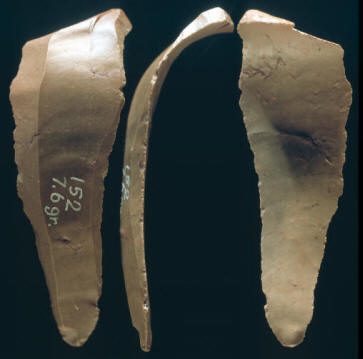
CLICK ON PICTURE FOR LARGER IMAGE
CORE BLADE
FENN CACHE
BORDER AREA OF UTAH, IDAHO OR WYOMING
This is the only
unifacial tool found in the Fenn cache. It's a typical Clovis blade that
was struck from a prepared core. Previous blade removal scars can be
seen on the surface. This blade is described as having dulled edges,
possibly from use. It's made of Green River Formation chert and it
measures 2 5/8 inches (6.8 cm) long. |
|
|
The most exotic material
in the Fenn Cache is Quartz
crystal. This material has turned up in the form of Clovis points from
coast-to-coast in the United States. So for either esthetic (beautiful),
or for some other reason, this glass-like material was sought after by
Paleo-Indian tool makers. The Fenn cache contains three finished Clovis
points that were made from Quartz crystal that is slightly smoky. All
three points are described as possibly having been resharpened. |
|
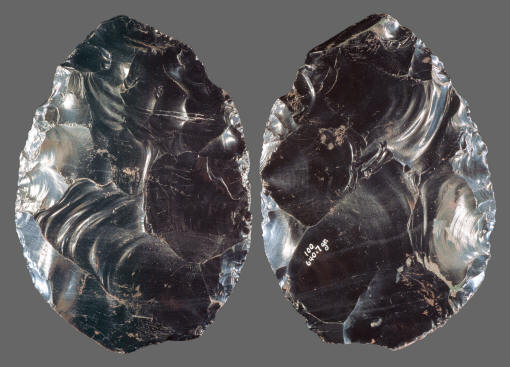
CLICK ON PICTURE FOR LARGER IMAGE
LARGEST BIFACE IN THE
CACHE
FENN CACHE
BORDER AREA OF UTAH, IDAHO OR WYOMING
This is the largest biface that was
found in the Fenn cache. It's a "classic" example of a type that is often referred to as a "platter biface" because of its large
round shape. Another name used in reference to these very large
bifaces is "biface core" because the large flakes they produce could
supply material for a number of different types of tools. The edge trimming
on this biface is described as possible platform
preparations for setting up further flake removals. The largest
Clovis "platter" biface discovered in a cache was found in the
Montana Anzick cache. It measured 12 3/8 inches (31.4 cm) long. This
example is made of opaque Obsidian and it measures 8 5/16 inches
(21.1 cm) long and 5 3/4 inches (14.5 cm) wide. |
|
|
The Fenn cache is covered
with a coating of red ochre that adheres to the surface of
most of the artifacts. The color red is a representation of blood and life. So this extra addition to the
cache does suggest a possible ritual connection. Other Clovis caches that
have coatings of red ochre include Anzick, East Wenatchee, and the
Simons cache. One of the most recent discoveries of a Clovis cache, the
Mahaffy cache, was not coated with red ochre. |
|
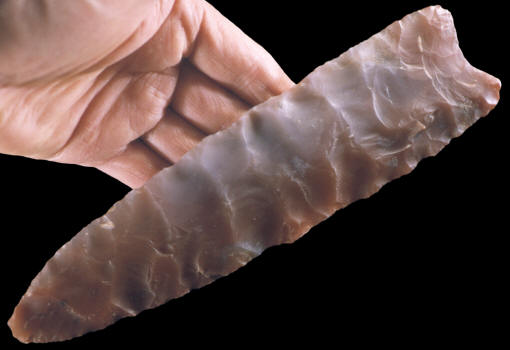
CLICK ON PICTURE FOR LARGER IMAGE
LONGEST CLOVIS POINT IN THE CACHE
FENN CACHE
BORDER AREA OF UTAH, IDAHO OR WYOMING
This is the longest Clovis point that was found in
the Fenn cache and the fourth longest artifact that was found in the
cache. It's described as an unfinished Clovis point that a
"good knapper" would only need a few minutes to complete. But in its
present form it's not impossible that it could have served as a
knife. This point was skillfully made using nice even percussion
flaking. It's made from a beautiful piece of translucent red and
purple Utah Agate. It measures 8 5/16 inches (21.2 cm) long. |
|
|
The Fenn cache contains
one crescent which is important for the fact that it's the only known
example ever found in a Clovis cache. Although the known history
surrounding the discovery of the Fenn cache is not what everyone would
like. This crescent does seem to belong to the assemblage because it's
made from the same Green River Formation chert as other artifacts in the
group and it's also coated with red ochre. Some archaeologists believe
the Great Basin Stemmed Point Tradition, a possible source for this
crescent, is either directly or indirectly connected to Clovis.
Indirectly because these types of stemmed points are believed by some to
predate Clovis. So the Fenn crescent may help to establish that the Great
Basin Stemmed Point Tradition (also referred
to as the Western Stemmed Point Tradition)
was either contemporaneous with Clovis or possibly older than the Clovis
culture. Another source describes crescents that have been found on the
surface in California along with small Clovis-like points. |
|
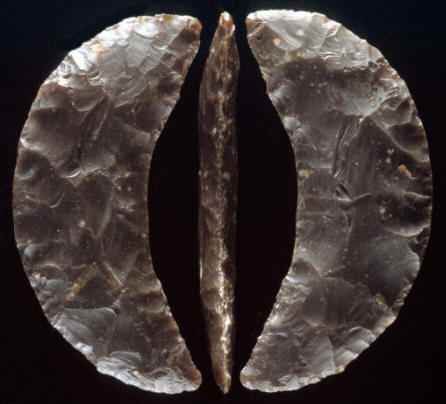
CLICK ON PICTURE FOR LARGER IMAGE
CRESCENT
FENN CACHE
BORDER AREA OF UTAH, IDAHO OR WYOMING
This is the only crescent found in the Fenn cache and in fact it's
the only known example ever found in a Clovis cache. It's described
as having sharp edges at both ends but the middle area on both sides
have been dulled by grinding. Although the
known history surrounding the discovery of the Fenn cache is not
what everyone would like. This crescent does seem to belong to the
assemblage because it is made from the same Green River Formation
chert as other artifacts in the group and it's also coated with red
ochre. Crescent is the term that is most often used to describe these uniquely shaped
early tool forms. But in fact, they were actually described and
named Great Basin Transverse points by C.W. Clewlow Jr. in 1968.
Most crescents are curved with a concave edge on one side and a
convex edge on the other so the descriptive word
"crescent" is most often used. Some archaeologists believe the Great Basin Stemmed Point
Tradition, which is a possible source for this crescent, is either
directly or indirectly connected to Clovis. Indirectly because these
types of stemmed points are believed by some to predate Clovis. So this
crescent may help to establish that the Great Basin Stemmed Point
Tradition (also referred to as the Western
Stemmed Point Tradition) was
either contemporaneous with Clovis or possibly older than the Clovis
culture. Another source describes crescents that have been found on
the surface in California along with small Clovis-like points. This
crescent measures 2 3/8 inches (6 cm) long. |
|
|
Only one
unifacial tool was found in the Fenn cache. It's a typical Clovis blade that
was struck from a prepared core. Previous blade removal scars are
evident on the surface. This blade is described as having dulled edges,
possibly from use. It's made of Green River Formation chert and it
measures 2 5/8 inches (6.8 cm) long. |
|
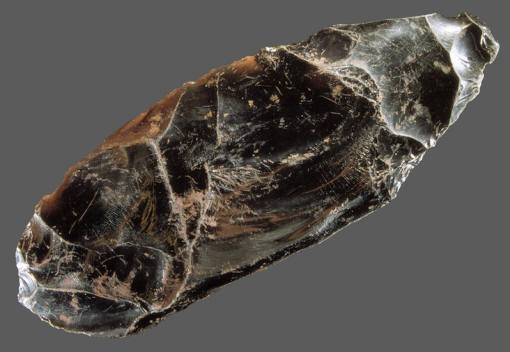
CLICK ON PICTURE FOR LARGER IMAGE
BIFACE
BEST EXAMPLE OF OVER-SHOT FLAKING
FENN CACHE
BORDER AREA OF UTAH, IDAHO OR WYOMING
This
is one of the more interesting bifaces in the Fenn cache because it
has the best example of an over-shot flake removal. One flake
removed nearly 4 inches (3 13/16 inches (9.7 cm) of an opposite
edge. Another smaller over-shot flake can be seen near the point.
The opposite side has an over-shot flake that measures 2 inches (5.1
cm) wide. This biface is made of opaque black Obsidian and it
measures 7 5/8 inches (19.4 cm) long. |
|
|
The Fenn cache did
produce one artifact that is exceptional for the craftsmanship it
displays. It's in the form of a finished Clovis point, #149. It's most
remarkable feature is the very uniform diagonal and parallel
edge-to-edge flaking pattern that was accomplished by a very skilled
Clovis knapper. This type of flaking is also referred to as an outré
passe flaking pattern. These flakes were removed by percussion.
Some
flintknappers believe this manufacturing technique was done by indirect
percussion flaking. Today's most expert flintknappers would find it very
difficult to duplicate. This type of flaking is not rare in western
Clovis but it's rare to see it so uniformly done. The other remarkable
feature about this point is that it's made from a blood red colored
stone that is red jasper from the Bighorn Mountains in northern Wyoming.
The fact that this large Clovis point was so remarkably well crafted out
of red blood colored stone similar to the color of red ochre, might
suggest that its intended purpose was to be used as a "special ritual
item." This Clovis point measures 6 inches (15.2 cm) long and 1 13/16
inches (4.6 cm) wide. |
|
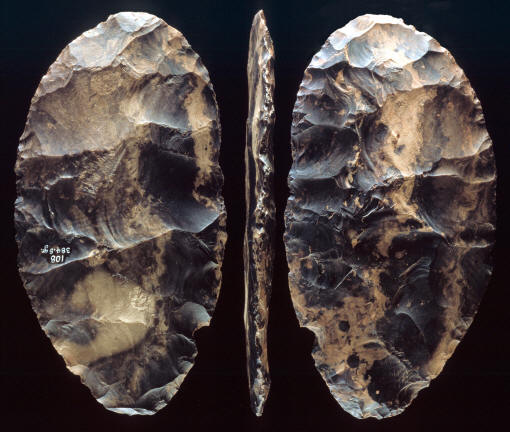
CLICK ON PICTURE FOR LARGER IMAGE
BIFACE
FENN CACHE
BORDER AREA OF UTAH, IDAHO OR WYOMING
This biface is the seventh longest
artifact in the Fenn cache. The many large percussion flake removal
scars that can be seen on both sides are very impressive. This
biface is described as being especially thin and the finishing work
that was done to the edges may suggest that it was intended to be
used as a knife. This biface is made of Green River Formation chert.
It measures 8 1/16 inches (20.4 cm) long, 4 1/4 inches (10.8 cm)
wide and 9/16 inch (13.9 mm) thick. |
|
|
Some Clovis caches
contain only unused artifacts in their assemblage. Most of the items in
the Fenn cache were newly made and never used but several of the
Clovis points were damaged and resharpened from use. At least five
Clovis points might have received their broken tips from impact damage.
One Obsidian point that snapped near the center may also have been
damage from impact. Two other Clovis points have a portion of one basal
ear broken off and there are two tips of finished Clovis points that may
have broke during use. The three complete crystal Clovis points
in the Fenn cache are also described as possibly having been resharpened. |
|
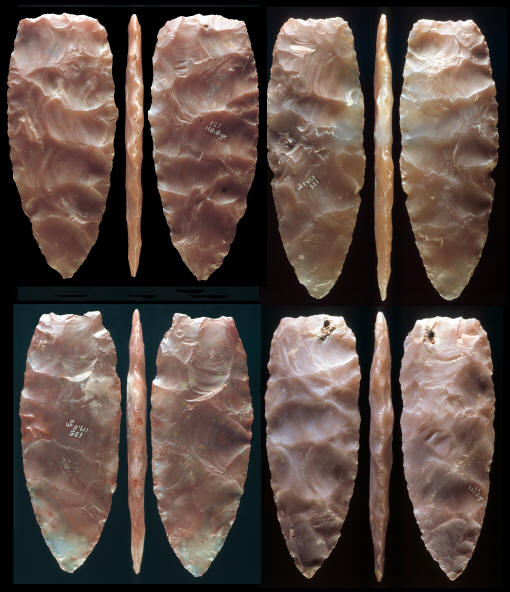
CLICK ON PICTURE FOR LARGER IMAGE
UTAH AGATE BIFACES
FENN CACHE
BORDER AREA OF UTAH, IDAHO OR WYOMING
All four of these Clovis bifaces are
made of Utah agate. They all have a lanceolate form that suggests
they probably represent early stages of finished Clovis points.
The biface at top left was made with nicely done evenly spaced
percussion flaking. It measures 5 7/8 inches (15 cm) long.
The biface at top right is another example of a well made and
better than average flaked biface from the cache. It measures 7 3/4
inches (196.5 cm) long.
The biface at lower left is described as having enough pressure
finishing-flaking done to the edge near the tip that it might
suggest its intended use as a knife. This biface also has two very
large end thinning flute flakes that were removed from both sides of
the base. This point measures 5 7/8 inches (14.9 cm) long.
The biface at lower right is typical of other examples in the
cache. It was bifacially shaped with very large percussion flake
removals and roughly pressure trimmed along the edges. This biface
also has one large end thinning flute flake scar on one side. The
large inclusion-flaw near the base possibly would have made it
difficult to finish the biface into a Clovis point unless its length
was reduced. This biface measures 7 7/16 inches (18.9 cm) long. |
|
|
Clovis caches are one of
the most important sources for Early Paleo-Indian research. They have
been most useful in the area of understanding Clovis manufacturing
technology because caches have produced the best study pieces. These
assemblages have produced all the different stages of manufacture from
extremely large biface cores to small resharpened and use damaged Clovis
points. Caches can also indicate Clovis movement patterns by tracking
artifact material source locations. Clovis caches are also useful for
providing archaeologists with the best examples of different types of
Clovis tool forms.
Caches have produced the largest Clovis points, the largest bifaces and
some of the largest core blades. |
|

CLICK ON PICTURES FOR LARGER IMAGE
GREEN RIVER FORMATION BIFACES
FENN CACHE
BORDER AREA OF UTAH, IDAHO OR WYOMING
All four bifaces
in this picture are made of Green River Formation chert.
The biface at top left is described as having very irregular
flaking indicating it's at an early stage of bifacial reduction. One
large end thinning flake was removed on one side. This biface
measures 6 1/16 inches (15.4 cm) long.
The biface at top right is described as an unfinished Clovis point
or knife. This biface has several very large percussion flake
removals and the edge is roughly trimmed. It measures 4 5/8 inches
(11.7 cm) long.
The biface at bottom left has several very large percussion flake
removals like so many other bifaces in the Fenn cache. But one side
of this biface has two particularly large diagonal flakes removed
that is impressive. A large portion of the edge and one triangular
area on one side are original surfaces that have not yet been
removed. This is a very early stage biface. It measures 6 3/8 inches
(16.2 cm) long.
The biface at bottom right is described as having excellent control
of over-shot flaking. There are at least three large flakes that
extend across the full width of the biface. The edges are roughly
trimmed. This biface measures 5 13/16 inches (14.7 cm) long. |
|
|
It's a good bet that
there are more Clovis caches buried in the ground. The Fenn cache was a
great discovery for archaeological research. It's hard to imagine
another one just as nice. A new cache could turn up at any time, in the
next shovel full of garden dirt, cultivated field or earth moving
construction project. So another discovery, if it's anything like the
Fenn cache, is something we can all look forward to. |
|
"REFERENCES"
1912, Hodge, Frederick Webb, "Cache
Discs and blades," Handbook Of American Indians
North Of Mexico, part 1, p. 178.
1999, Frison, George & Bradley, Bruce, "The Fenn Cache, Clovis
Weapons & Tools."
1999, Frison, George, "The Late Pleistocene Prehistory of the
Northwestern Plains, the Adjacent mountains, and Intermontane Basins," The
Ice Age Peoples Of North America, Environments, Origins, and Adaptations,
p. 272-273.
1999, Bouldurian, Anthony T., Cotter, John L., "Clovis Revisited,
New Perspectives On Paleoindian Adaptations From Blackwater Draw, New
Mexico," p. 28-29, (Clovis Core Reduction).
2005, Alan L., Bryan & Donald R. Tuohy, "Prehistory Of
The Great Basin/Snake River Plain To About 8,500 Years Ago,"
Ice Age Peoples Of North America, pp. 252 & 258.
2010, Kohntopp, Steve W., "The Simon Clovis Cache."
2012, Stanford, Dennis J., Bradley, Bruce A., "Across Atlantic
Ice, The Origin Of America's Clovis Culture," p. 43.
|
|
RECENT
LISTINGS HOME
ORDERING |
